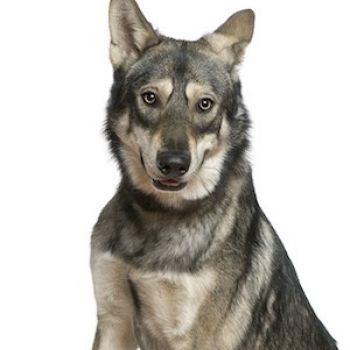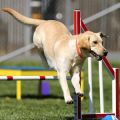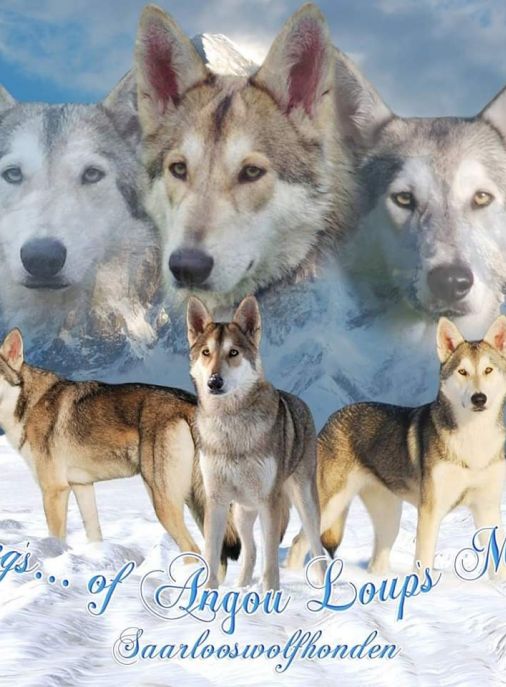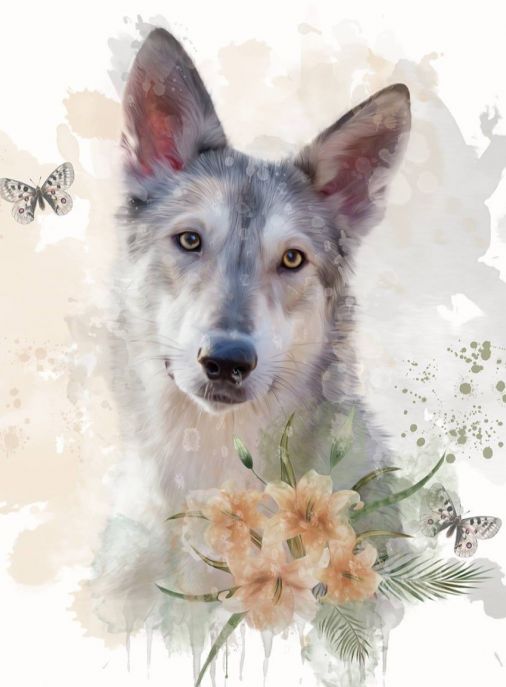The Saarloos Wolfhond, also known as the Saarloos Wolfdog, is a captivating and majestic breed that exudes an air of wild beauty. This breed is a result of the crossing between a German Shepherd and a Eurasian Grey Wolf, creating a unique hybrid that possesses both the physical traits and the spirit of its wolf ancestors. With its striking appearance and fascinating history, the Saarloos Wolfhond has become a beloved breed among dog enthusiasts worldwide.
The history of the Saarloos Wolfhond dates back to the early 20th century when a Dutch breeder named Leendert Saarloos sought to create a breed that combined the loyalty and intelligence of a domestic dog with the strength and resilience of a wolf. Saarloos believed that by introducing wolf blood into the German Shepherd breed, he could enhance its natural instincts and create a more robust and versatile working dog.
Saarloos began his breeding program in the 1920s, carefully selecting German Shepherds with desirable traits and crossing them with Eurasian Grey Wolves. The goal was to create a breed that possessed the wolf's physical characteristics, such as a strong, muscular body, a thick double coat, and a distinctive wolf-like appearance. However, Saarloos also aimed to temper the wolf's wild nature with the German Shepherd's loyalty and trainability.
After several generations of selective breeding, Saarloos successfully established a breed that he believed embodied his vision. In 1975, the Saarloos Wolfhond was officially recognized by the Fédération Cynologique Internationale (FCI) as a distinct breed. Today, the breed is classified under FCI Group 1, Section 1: Sheepdogs and Cattle Dogs, and bears the standard number 311.
The Saarloos Wolfhond is primarily bred for its working abilities and is known for its exceptional strength, agility, and endurance. These dogs excel in various tasks, including search and rescue, tracking, herding, and even as assistance dogs. Their keen senses and intelligence make them highly trainable, although they require experienced handlers who can provide consistent and firm leadership.
In terms of physical characteristics, the Saarloos Wolfhond is a large and robust breed. Males typically stand between 24 to 30 inches (60 to 75 cm) at the shoulder, while females are slightly smaller, ranging from 22 to 28 inches (55 to 70 cm). The breed's weight varies between 70 to 90 pounds (32 to 41 kg) for males and 60 to 80 pounds (27 to 36 kg) for females. Their strong, muscular build and deep chest contribute to their impressive physical presence.
One notable feature of the Saarloos Wolfhond is its dense, weather-resistant double coat. The outer coat is straight and coarse, while the undercoat is thick and soft, providing excellent insulation in colder climates. The breed's coat color can vary, but it typically ranges from various shades of gray to silver or cream. Their striking appearance, combined with their piercing amber or yellow eyes, gives them an almost mystical allure.
In terms of temperament, the Saarloos Wolfhond is known for its loyalty, intelligence, and strong pack instincts. These dogs form deep bonds with their families and are incredibly protective. However, they can be reserved and aloof with strangers, making them excellent guard dogs. Early socialization and consistent training are crucial to ensure they develop into well-rounded and balanced individuals.
The average lifespan of a Saarloos Wolfhond is around 10 to 12 years, although with proper care and nutrition, some individuals have been known to live longer. Regular exercise is essential for this breed, as they have high energy levels and require mental and physical stimulation to thrive. Long walks, runs, and engaging activities such as obedience training or agility courses are ideal for keeping them happy and healthy.
It is important to note that the Saarloos Wolfhond is not recommended for novice dog owners or those who cannot provide the necessary time and commitment. Their strong wolf instincts require a firm and consistent hand, and they thrive in homes with experienced handlers who can provide them with the guidance and structure they need.
In conclusion, the Saarloos Wolfhond is a remarkable breed that combines the grace and beauty of a wolf with the loyalty and intelligence of a domestic dog. With its striking appearance, impressive working abilities, and strong pack instincts, this breed has carved a special place in the hearts of dog enthusiasts worldwide. Whether as a working companion or a devoted family pet, the Saarloos Wolfhond continues to captivate and inspire with its wild spirit and unwavering loyalty.
The Saarloos Wolfhond is a majestic and intelligent breed of dog that possesses a unique character and behavior. Developed by Dutch breeder Leendert Saarloos in the early 20th century, this breed is a cross between a German Shepherd and a Eurasian Wolf. As a result, Saarloos Wolfhonds exhibit a fascinating blend of wolf-like traits and domestic dog characteristics.
In terms of their character, Saarloos Wolfhonds are known for their loyalty and strong bond with their family. They are incredibly protective and make excellent guard dogs. However, they can be reserved and cautious around strangers, which is a trait inherited from their wolf ancestry. This cautiousness makes them excellent watchdogs, as they are always alert and aware of their surroundings.
These dogs are highly intelligent and require mental stimulation to thrive. They are quick learners and enjoy engaging in activities that challenge their minds. Regular training sessions, both obedience and agility, are essential to keep their minds sharp and prevent boredom. Positive reinforcement techniques work best with this breed, as they respond well to praise and rewards.
Socialization is crucial for Saarloos Wolfhonds from an early age. They need to be exposed to various people, animals, and environments to ensure they grow up to be well-rounded and confident dogs. Early socialization helps them develop good manners and reduces the likelihood of fear or aggression towards unfamiliar situations.
Saarloos Wolfhonds have a strong pack instinct, which means they thrive in a family environment where they feel like a valued member of the pack. They are not well-suited for living in isolation or being left alone for long periods. These dogs require regular exercise and mental stimulation to prevent destructive behaviors that may arise from boredom or frustration.
When it comes to raising and training a Saarloos Wolfhond, consistency and patience are key. They are sensitive dogs that respond best to gentle guidance and positive reinforcement. Harsh training methods or punishment can lead to fear or aggression, so it is important to establish a bond built on trust and respect.
Saarloos Wolfhonds have a strong prey drive, so it is crucial to keep them on a leash or in a securely fenced area when outside. Their wolf-like instincts may lead them to chase small animals, which can be dangerous for both the dog and the prey.
In conclusion, Saarloos Wolfhonds are a unique and fascinating breed with a strong character. They are loyal, protective, and intelligent dogs that require proper socialization, training, and mental stimulation. With the right care and guidance, these majestic dogs can become loving and devoted companions for those who appreciate their wolf-like qualities.
The Saarloos Wolfhond is a majestic and intelligent breed that requires specific care to ensure their well-being and happiness. Here are some tips on how to care for Saarloos Wolfhond dogs, including what to do and what not to do:
1. Socialization is key: Saarloos Wolfhonds are known for their reserved nature, so early and consistent socialization is crucial. Expose them to various people, animals, and environments from a young age to help them develop confidence and prevent fear-based aggression.
2. Exercise and mental stimulation: These dogs have a high energy level and need regular exercise to stay physically and mentally fit. Daily walks, runs, or play sessions in a securely fenced area are essential. Engage them in activities like obedience training, agility, or scent work to keep their minds stimulated.
3. Provide a secure environment: Saarloos Wolfhonds have a strong prey drive and may be prone to wander. Ensure your yard is securely fenced, with no gaps or loose boards. Supervise them during outdoor activities to prevent them from escaping or chasing after small animals.
4. Grooming needs: Saarloos Wolfhonds have a thick double coat that requires regular brushing to prevent matting and remove loose hair. They shed seasonally, so expect heavier shedding during spring and fall. Bathing should be done only when necessary to avoid stripping their coat of natural oils.
5. Proper nutrition: Feed your Saarloos Wolfhond a high-quality, balanced diet suitable for their age, size, and activity level. Consult with a veterinarian to determine the appropriate amount and type of food. Avoid overfeeding to prevent obesity, which can lead to various health issues.
6. Positive reinforcement training: Saarloos Wolfhonds respond best to positive reinforcement techniques such as praise, treats, and play. Harsh training methods or punishment can damage their trust and cause behavioral issues. Use rewards to motivate and reinforce desired behaviors.
7. Regular veterinary care: Schedule regular check-ups with a veterinarian to monitor your Saarloos Wolfhond's health. Vaccinations, parasite prevention, dental care, and routine blood work are essential. Early detection of any health issues can lead to better outcomes.
8. Mental and emotional well-being: Saarloos Wolfhonds thrive when they have a strong bond with their owners. Spend quality time with them, provide mental stimulation through interactive toys or puzzles, and engage in activities that challenge their intelligence. Avoid leaving them alone for extended periods as they may develop separation anxiety.
9. Avoid harsh climates: Saarloos Wolfhonds have a dense coat that provides insulation, but they are not well-suited for extremely hot or cold climates. In hot weather, provide shade, fresh water, and avoid exercising them during the hottest parts of the day. In cold weather, provide a warm shelter and consider using doggy clothing to protect them from the elements.
10. Avoid overexposure to loud noises: Saarloos Wolfhonds can be sensitive to loud noises, which may cause anxiety or stress. During fireworks, thunderstorms, or other noisy events, create a safe and quiet space for them indoors. Consider using calming aids like pheromone diffusers or anxiety wraps if needed.
Remember, every Saarloos Wolfhond is unique, and individual care requirements may vary. Always prioritize their physical and emotional well-being, and consult with a professional dog trainer or veterinarian for personalized advice.
The Saarloos Wolfhond, also known as the Saarloos Wolfdog, is a majestic and striking breed that possesses a unique and captivating coat color. The common color of Saarloos Wolfhond dogs is a mesmerizing combination of various shades of gray, ranging from light silver to deep charcoal, which beautifully mimics the appearance of their wild wolf ancestors.
The base color of the Saarloos Wolfhond's coat is typically a medium to dark gray, resembling the color of stormy skies. This primary hue is often accentuated by lighter shades of gray that can be found on the underbelly, chest, and legs, creating a stunning contrast against the darker tones. The lighter shades of gray may vary in intensity, ranging from a pale silver to a soft, dove gray.
One of the most captivating features of the Saarloos Wolfhond's coat is the presence of a unique and enchanting pattern known as agouti. This pattern is characterized by individual hairs that have alternating bands of light and dark color, creating a mesmerizing effect. The agouti pattern is most commonly seen on the back, sides, and tail of the Saarloos Wolfhond, adding depth and texture to their already striking appearance.
In addition to the various shades of gray and the agouti pattern, Saarloos Wolfhond dogs may also exhibit subtle hints of other colors within their coat. These additional colors can include touches of cream, white, or even black, which further enhance the complexity and beauty of their overall appearance.
The Saarloos Wolfhond's coat is typically dense and thick, providing protection against harsh weather conditions. This luxurious coat not only adds to their regal and majestic appearance but also serves a practical purpose in keeping them warm during colder months.
It is important to note that while the common color of Saarloos Wolfhond dogs is predominantly gray, variations in coat color can occur within the breed. Some individuals may exhibit a slightly lighter or darker shade of gray, while others may have more pronounced markings or a different distribution of colors. These variations add to the uniqueness and individuality of each Saarloos Wolfhond, making them even more captivating and visually stunning.
In conclusion, the common color of Saarloos Wolfhond dogs is a captivating combination of various shades of gray, ranging from light silver to deep charcoal. Their coat is often accentuated by lighter shades of gray and may exhibit the mesmerizing agouti pattern. With their striking appearance and regal presence, Saarloos Wolfhond dogs truly embody the beauty and grace of their wild wolf ancestors.
The Saarloos Wolfhond is a majestic and unique breed of dog that originated in the Netherlands. Bred by crossing German Shepherds with European wolves, these dogs possess a striking appearance and a strong, athletic build. When it comes to their health, Saarloos Wolfhonds are generally a robust and healthy breed. However, like all dogs, they are prone to certain health issues that owners should be aware of.
One of the most common health concerns in Saarloos Wolfhonds is hip dysplasia. This is a genetic condition where the hip joint doesn't develop properly, leading to pain, lameness, and arthritis. Responsible breeders will conduct hip evaluations on their breeding dogs to minimize the risk of passing on this condition. Regular exercise, a balanced diet, and maintaining a healthy weight can help reduce the severity of hip dysplasia in affected dogs.
Another health issue that can affect Saarloos Wolfhonds is progressive retinal atrophy (PRA). PRA is a degenerative eye disease that causes gradual vision loss and can eventually lead to blindness. Regular eye examinations by a veterinary ophthalmologist can help detect PRA early on, allowing for appropriate management and support for affected dogs. It is crucial for breeders to screen their breeding dogs for PRA to reduce the risk of passing it on to future generations.
Like many large breeds, Saarloos Wolfhonds are also prone to bloat, also known as gastric dilatation-volvulus (GDV). This is a life-threatening condition where the stomach fills with gas and twists on itself. Immediate veterinary attention is required if bloat is suspected. To minimize the risk of bloat, it is recommended to feed Saarloos Wolfhonds smaller, frequent meals, avoid vigorous exercise immediately after eating, and use elevated feeding bowls.
Regular veterinary check-ups, vaccinations, and preventive treatments for parasites such as fleas, ticks, and heartworms are essential for maintaining the overall health of Saarloos Wolfhonds. Routine dental care, including regular teeth brushing and professional cleanings, can help prevent dental diseases such as periodontal disease and tooth loss.
Exercise is crucial for the physical and mental well-being of Saarloos Wolfhonds. These dogs have high energy levels and require daily exercise to prevent boredom and destructive behaviors. Long walks, jogging, hiking, and interactive play sessions are great ways to keep them physically and mentally stimulated. Mental enrichment activities, such as puzzle toys and obedience training, can also help keep their minds sharp.
Proper nutrition is vital for the health of Saarloos Wolfhonds. A high-quality, balanced diet that meets their nutritional needs is essential. Consultation with a veterinarian can help determine the appropriate diet for your dog based on their age, activity level, and any specific dietary requirements.
Regular grooming is necessary to maintain the coat and skin health of Saarloos Wolfhonds. They have a dense double coat that requires brushing at least once a week to remove loose hair and prevent matting. Bathing should be done as needed, using a gentle dog shampoo to avoid skin irritation.
In conclusion, while Saarloos Wolfhonds are generally a healthy breed, they are prone to certain health issues such as hip dysplasia, progressive retinal atrophy, and bloat. Responsible breeding practices, regular veterinary care, proper nutrition, exercise, and grooming are essential for maintaining the overall health and well-being of these magnificent dogs. With proper care, Saarloos Wolfhonds can lead long, happy, and healthy lives as beloved companions.
The Saarloos Wolfhond is a magnificent breed known for its wolf-like appearance and gentle nature. When it comes to their nutrition, it is essential to provide them with a well-balanced diet that meets their specific needs. This breed requires a diet that supports their overall health, energy levels, and maintains their lean physique. Here is an extensive description of the nutrition requirements for Saarloos Wolfhond dogs, along with advice on feeding and things to avoid.
Protein is a crucial component of a Saarloos Wolfhond's diet. It aids in muscle development, repair, and overall growth. High-quality animal-based proteins should be the foundation of their diet. Look for dog food that lists whole meat sources like chicken, beef, or fish as the primary ingredient. Avoid foods that contain meat by-products or fillers, as they offer little nutritional value.
In addition to protein, Saarloos Wolfhond dogs require a moderate amount of healthy fats. Fats provide energy, support brain function, and help maintain a healthy coat and skin. Look for dog food that includes sources of healthy fats like fish oil, flaxseed, or chicken fat. Avoid foods that contain excessive amounts of saturated fats or artificial additives.
Carbohydrates are another essential component of a Saarloos Wolfhond's diet. However, it is important to choose complex carbohydrates that provide sustained energy rather than simple sugars. Whole grains like brown rice, oats, and barley are excellent choices. Avoid foods that contain excessive amounts of corn, wheat, or soy, as these can cause allergies or digestive issues in some dogs.
Fruits and vegetables are a valuable addition to a Saarloos Wolfhond's diet. They provide essential vitamins, minerals, and antioxidants. Incorporate a variety of fruits and vegetables into their meals, such as carrots, sweet potatoes, blueberries, and spinach. Avoid feeding them toxic foods like grapes, raisins, onions, or garlic, as these can be harmful to dogs.
Feeding a Saarloos Wolfhond should be done in appropriate portions to maintain a healthy weight. Obesity can lead to various health issues, including joint problems and decreased lifespan. Follow the feeding guidelines provided by the dog food manufacturer, but also consider your dog's activity level, age, and overall health. Adjust the portion sizes accordingly to prevent overfeeding or underfeeding.
It is important to note that Saarloos Wolfhond dogs have a sensitive digestive system. Avoid sudden changes in their diet, as it can lead to gastrointestinal upset. If you need to switch their food, do it gradually over a period of 7-10 days, gradually increasing the new food while decreasing the old food.
Always provide fresh water for your Saarloos Wolfhond. Hydration is crucial for their overall health and well-being. Make sure to clean their water bowl regularly to prevent the growth of bacteria.
Lastly, it is recommended to consult with a veterinarian to ensure you are meeting your Saarloos Wolfhond's specific nutritional needs. They can provide personalized advice based on your dog's age, weight, and any specific health concerns.
In conclusion, a well-balanced diet is essential for the health and vitality of Saarloos Wolfhond dogs. Provide them with high-quality proteins, healthy fats, complex carbohydrates, and a variety of fruits and vegetables. Avoid foods with low nutritional value, excessive fats, sugars, or artificial additives. Feed them in appropriate portions and avoid sudden diet changes. By following these guidelines and consulting with a veterinarian, you can ensure your Saarloos Wolfhond receives the nutrition they need to thrive.







